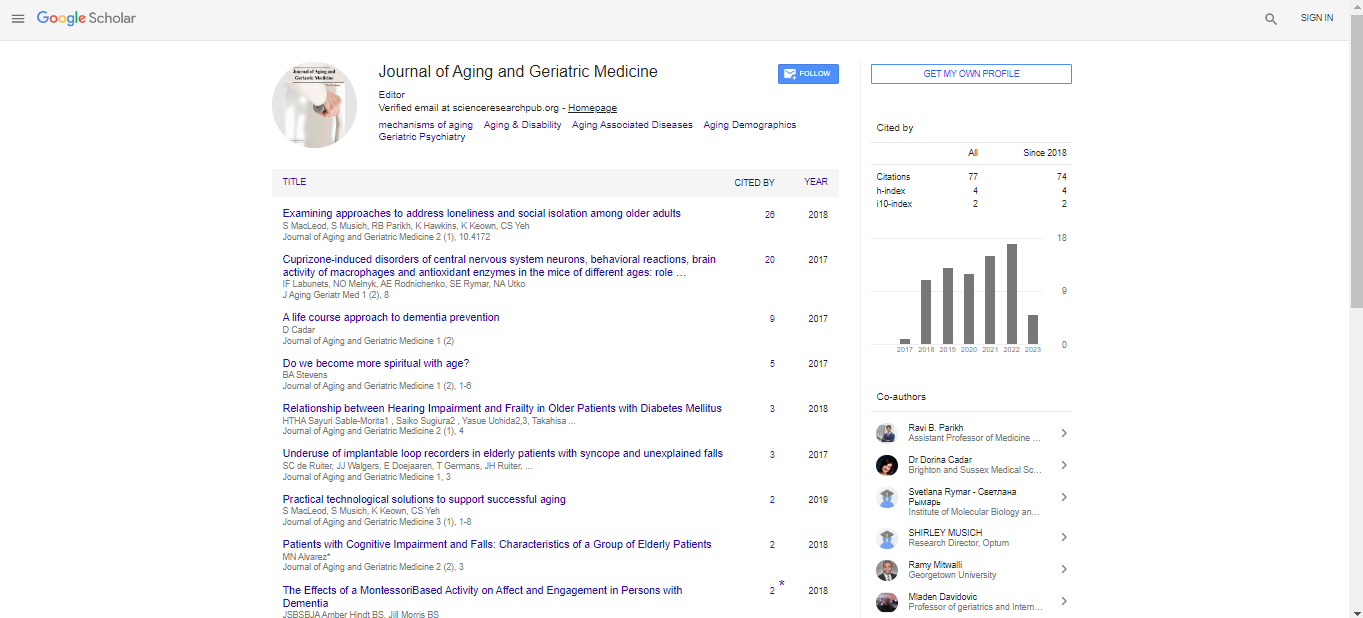Editorial, J Aging Geriatr Med Vol: 8 Issue: 2
Depression in Aging: Understanding and Addressing a Silent Epidemic
Lan Xiong*
Department of Social Preventive Medical Sciences, University of British Columbia, Canada
- *Corresponding Author:
- Lan Xiong
Department of Social Preventive Medical Sciences, University of British Columbia, Canada
E-mail: lan735@gmail.com
Received: 01-Jan-2025, Manuscript No. agm-25-169751; Editor assigned: 4-Jan-2025, Pre-QC No. agm-25-169751 (PQ); Reviewed: 18-Jan-2025, QC No. agm-25-169751; Revised: 25-Jan-2025, Manuscript No. agm-25-169751 (R); Published: 30-Jan-2025, DOI: 10.4172/2576-3946.1000185
Citation: Lan X (2025) Depression in Aging: Understanding and Addressing a Silent Epidemic. J Aging Geriatr Med 8: 185
Introduction
Depression is a common but often overlooked mental health issue among older adults. While aging brings many changes—physical, social, and emotional—depression in the elderly is frequently misunderstood as a normal part of aging, leading to underdiagnosis and undertreatment. However, depression in older adults is a serious condition that affects quality of life, physical health, and even mortality. Recognizing the signs, understanding its causes, and providing appropriate interventions are vital to improving the mental health and well-being of aging populations worldwide.
Depression is a common but often underrecognized mental health condition among older adults. While sadness and grief may be expected responses to life changes in aging, clinical depression is a serious disorder that significantly affects an individual’s mood, thoughts, and overall functioning. Unfortunately, depression in older adults is frequently mistaken as a normal part of aging or overshadowed by other chronic medical conditions, leading to underdiagnosis and under treatment [1], [2].
The aging process brings various physical, social, and psychological challenges that can increase vulnerability to depression. Factors such as loss of loved ones, chronic illnesses, reduced mobility, social isolation, and changes in cognitive function all contribute to the risk. Unlike younger populations, older adults may express depression more through physical symptoms like fatigue, sleep disturbances, or unexplained aches, which complicates detection [3], [4].
Left untreated, depression in aging can lead to severe consequences including impaired daily functioning, poorer management of chronic diseases, increased healthcare utilization, and even elevated risk of suicide. Recognizing and addressing depression in older adults is essential to improve their quality of life and overall well-being. Early identification, compassionate care, and appropriate treatment can make a profound difference in helping older individuals lead healthier, more fulfilling lives [5].
Discussion
Depression in aging is a significant yet frequently overlooked mental health issue that profoundly impacts the well-being of older adults. While sadness can be a normal emotional response to life changes such as retirement, bereavement, or declining health, clinical depression is not a normal part of aging. It is a diagnosable and treatable condition that often goes unrecognized due to overlapping symptoms with other medical conditions or the misconception that emotional distress is expected in old age.
Older adults with depression may present with less typical symptoms, such as fatigue, sleep disturbances, cognitive impairment, or physical complaints, rather than expressing overt sadness. These atypical presentations often lead to underdiagnosis or misdiagnosis, especially in those with coexisting chronic illnesses like heart disease, diabetes, or Parkinson’s disease. Furthermore, stigma around mental health in older generations may prevent individuals from seeking help or discussing their symptoms openly.
The risk factors for depression in aging are multifactorial. Biological factors include changes in brain chemistry and the presence of chronic illnesses. Psychosocial factors such as loneliness, social isolation, financial stress, and loss of independence also play significant roles. Caregivers themselves are at risk of depression due to the physical and emotional demands of caregiving.
Depression in older adults is associated with serious consequences, including functional decline, decreased quality of life, poor adherence to medical treatments, and increased mortality. It is also a major risk factor for suicide, particularly in older men.
Treatment options are effective and include a combination of pharmacological therapies (e.g., antidepressants), psychotherapy (especially cognitive-behavioral therapy), and lifestyle modifications such as exercise, social engagement, and healthy nutrition. Collaborative care models involving primary care providers, mental health professionals, and community resources have shown success in improving outcomes.
In conclusion, depression in aging is a complex and impactful condition that requires timely recognition and a holistic approach to management. Raising awareness, reducing stigma, and integrating mental health care into routine geriatric services are essential steps in improving the mental health and overall quality of life for older adults.
Role of Healthcare Providers and Caregivers
Healthcare providers should routinely screen older patients for depression, especially those with chronic illness or social isolation. Early intervention can prevent complications and improve quality of life.
Caregivers and family members play a crucial role in recognizing mood changes and encouraging treatment adherence. Supporting caregivers is also vital since caregiver burden can contribute to depression.
Conclusion
Depression in aging is a significant public health concern with far-reaching effects on individuals, families, and healthcare systems. Despite its prevalence, it remains underdiagnosed and undertreated due to stigma, atypical presentations, and diagnostic challenges. By increasing awareness, promoting routine screening, and offering effective treatments, society can improve the mental health and quality of life of older adults. Supporting older adults to remain socially connected, physically active, and emotionally supported is key to addressing this silent epidemic and ensuring healthy aging for future generations.
References
- Stein, Howard (2012) Synchronized Mechanical Ventilation Using Electrical Activity of the Diaphragm in Neonates. Cli Peri 39: 525â??542.
- Kallio Merja (2012) Electrical Activity of the Diaphragm during Neurally Adjusted Ventilatory Assist in Pediatric Patients. Pedia Pulmo 50: 925â??931.
- Rahmani A (2012) Neurally Adjusted Ventilatory Assist in the Neonatal Period: Applications and Limitations. J Neo-Peri Med 5: 205â??212.
- Shilpi M, Kumar K S, Kumar D (2020) Ayurvedic Approach Of Treatment Of Recurrent/ Chronic Cough In Children With Special Reference To Pancha Vidha Kasa. Ind J of App Res 10: 51-52.
- Nelaturi P, Nagarajan P, Sabapathy SK, Sambandam R (2021) Swarna Bindu Prashanaâ??an Ancient Approach to Improve the Infant’s Immunity. Bio Tra Ele Res 199: 2145-2148.
 Spanish
Spanish  Chinese
Chinese  Russian
Russian  German
German  French
French  Japanese
Japanese  Portuguese
Portuguese  Hindi
Hindi 